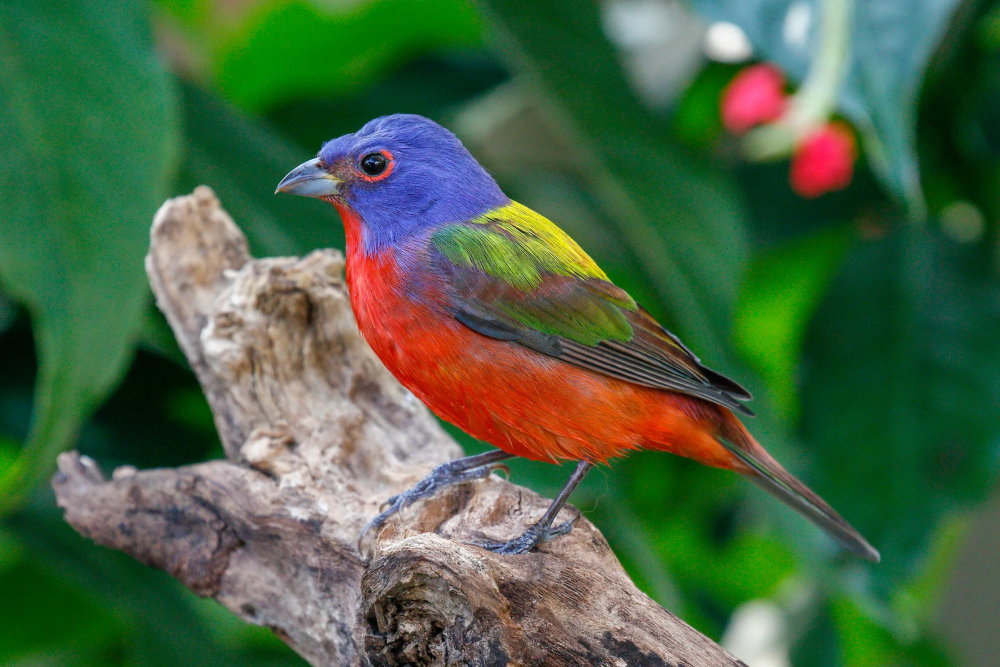In the intricate tapestry of avian beauty, few species stand out as vividly as the Painted Bunting (Passerina ciris). With its kaleidoscope of colors and mysterious allure, this small bird has captivated birdwatchers and nature enthusiasts for centuries. From its vibrant plumage to its melodious song, the Painted Bunting embodies the essence of nature’s artistry, leaving an indelible mark on those lucky enough to encounter it.
Appearance
The most striking feature of the Painted Bunting is undoubtedly its dazzling plumage. Males are resplendent in a medley of hues, sporting an electric blue head, a bright red breast, and a vibrant green back. The combination of these colors creates a mesmerizing spectacle, reminiscent of a painter’s palette come to life. Females, while less flamboyant, exhibit a subtle beauty of their own, with olive-green plumage that blends seamlessly into their woodland habitats.
This stark contrast between the sexes is a common trait among birds, often serving as a visual cue for mate selection. For the Painted Bunting, however, this divide goes beyond mere aesthetics, hinting at deeper evolutionary dynamics and ecological roles within their ecosystems.

Habitat and Distribution
Painted Buntings are primarily found in the southeastern United States, where they inhabit a variety of wooded habitats, including brushy areas, forest edges, and coastal thickets. Despite their vibrant appearance, these birds are remarkably elusive, often concealing themselves within dense foliage and shrubbery. Their secretive nature adds to their mystique, making sightings all the more special for those who catch a glimpse of these elusive creatures.
During the breeding season, male Painted Buntings establish territories adorned with lush vegetation, where they perform elaborate courtship displays to attract mates. Their distinctive songs fill the air, adding a musical dimension to their already enchanting presence. Despite their small size, Painted Buntings are accomplished singers, with each male boasting a unique repertoire of trills and warbles to serenade potential partners.
Behavior and Ecology
Beyond their aesthetic appeal, Painted Buntings play a vital role in their ecosystems as seed dispersers and insect predators. Their omnivorous diet consists of a variety of seeds, fruits, and insects, making them important agents of plant regeneration and pest control. By consuming fruits and dispersing seeds over wide areas, they help maintain the diversity and resilience of their habitats.
Despite their ecological significance, Painted Buntings face numerous threats to their survival, including habitat loss, predation, and climate change. The degradation and fragmentation of their woodland habitats have led to declines in their populations in certain areas, highlighting the urgent need for conservation efforts to protect these charismatic birds and their fragile ecosystems.
Conservation Efforts
So, thankfully, organizations and conservationists are actively working to safeguard the future of Painted Buntings and their habitats. Through habitat restoration, land conservation, and public awareness campaigns, efforts are underway to ensure that these avian jewels continue to grace our forests and wetlands for generations to come.
Citizen science initiatives, such as bird monitoring programs and community-based conservation projects, also play a crucial role in gathering data and raising awareness about the plight of Painted Buntings and other threatened species. By engaging the public in conservation efforts, these programs empower individuals to become stewards of their local environments and champions for biodiversity conservation.
Conclusion
In a world where natural beauty is increasingly scarce, the Painted Bunting stands as a beacon of hope and inspiration. Its radiant plumage, melodic songs, and enigmatic presence remind us of the extraordinary diversity and wonder of the natural world. So, by cherishing and protecting these exquisite creatures, we not only preserve a piece of our natural heritage but also reaffirm our commitment to coexisting harmoniously with the myriad life forms that share our planet. In the delicate balance of nature, the Painted Bunting serves as a reminder that every species, no matter how small, plays a vital role in the intricate web of life.









